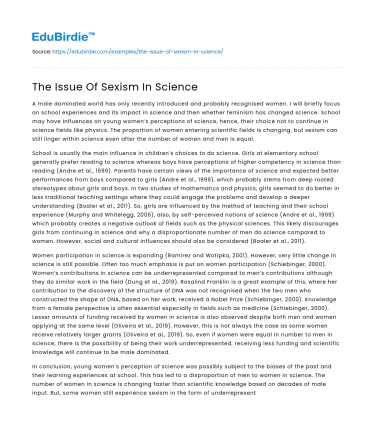A male dominated world has only recently introduced and probably recognised women. I will briefly focus on school experiences and its impact in science and then whether feminism has changed science. School may have influences on young women’s perceptions of science, hence, their choice not to continue in science fields like physics. The proportion of women entering scientific fields is changing, but sexism can still linger within science even after the number of women and men is equal.
School is usually the main influence in children’s choices to do science. Girls at elementary school generally prefer reading to science whereas boys have perceptions of higher competency in science than reading (Andre et al., 1999). Parents have certain views of the importance of science and expected better performances from boys compared to girls (Andre et al., 1999), which probably stems from deep rooted stereotypes about girls and boys. In two studies of mathematics and physics, girls seemed to do better in less traditional teaching settings where they could engage the problems and develop a deeper understanding (Boaler et al., 2011). So, girls are influenced by the method of teaching and their school experience (Murphy and Whitelegg, 2006), also, by self-perceived notions of science (Andre et al., 1999) which probably creates a negative outlook of fields such as the physical sciences. This likely discourages girls from continuing in science and why a disproportionate number of men do science compared to women. However, social and cultural influences should also be considered (Boaler et al., 2011).
Save your time!
We can take care of your essay
- Proper editing and formatting
- Free revision, title page, and bibliography
- Flexible prices and money-back guarantee
Women participation in science is expanding (Ramirez and Wotipka, 2001). However, very little change in science is still possible. Often too much emphasis is put on women participation (Schiebinger, 2000). Women’s contributions in science can be underrepresented compared to men’s contributions although they do similar work in the field (Dung et al., 2019). Rosalind Franklin is a great example of this, where her contribution to the discovery of the structure of DNA was not recognised when the two men who constructed the shape of DNA, based on her work, received a Nobel Prize (Schiebinger, 2000). Knowledge from a female perspective is often essential especially in fields such as medicine (Schiebinger, 2000). Lesser amounts of funding received by women in science is also observed despite both men and women applying at the same level (Oliveira et al., 2019). However, this is not always the case as some women receive relatively larger grants (Oliveira et al., 2019). So, even if women were equal in number to men in science, there is the possibility of being their work underrepresented, receiving less funding and scientific knowledge will continue to be male dominated.
In conclusion, young women’s perception of science was possibly subject to the biases of the past and their learning experiences at school. This has led to a disproportion of men to women in science. The number of women in science is changing faster than scientific knowledge based on decades of male input. But, some women still experience sexism in the form of underrepresented work or less funding for scientific research. Other factors including society and culture also influence sexism in science which was not fully considered. So, I do believe sexism is still present in science especially in scientific knowledge.
References
- Andre, T. et al. (1999) ‘Competency Beliefs, Positive Affect, and Gender Stereotypes of Elementary Students and Their Parents about Science versus Other School Subjects’, Journal of Research in Science Teaching, 36(6), pp. 719–747.
- Boaler, J., Altendorff, L. and Kent, G. (2011) ‘Mathematics and science inequalities in the United Kingdom: When elitism, sexism and culture collide’, Oxford Review of Education, 37(4), pp. 457–484. doi: 10.1080/03054985.2011.595551.
- Dung, S. K. et al. (2019) ‘Illuminating Women’s Hidden Contribution to Historical Theorectical Population Genetics’, Genetics, 211(2), pp. 363–366. doi: 10.1534/genetics.118.301277.
- Murphy, P. and Whitelegg, E. (2006) ‘Girls and physics: continuing barriers to “belonging”’, The Curriculum Journal, 17(3), pp. 281–305. doi: 10.1080/09585170600909753.
- Oliveira, D. F. M. et al. (2019) ‘Comparison of National Institutes of Health Grant Amounts to First-Time Male and Female Principal Investigators’, Jama, 321(9), pp. 898–900. doi: 10.1001/JAMA.2018.21944.
- Ramirez, F. O. and Wotipka, C. M. (2001) ‘Slowly but Surely ? The Global Expansion of Women ’ s Participation in Science and Engineering Fields of Study , 1972-92’, Sociology of Education, 74(3), pp. 231–251. Available at: https://www.jstor.org/stable/2673276.
- Schiebinger, L. (2000) ‘Has Feminsm Changed Science?’, Signs: Journal of Women in Culture and Society, 25(4), pp. 1171–1175.






 Stuck on your essay?
Stuck on your essay?

